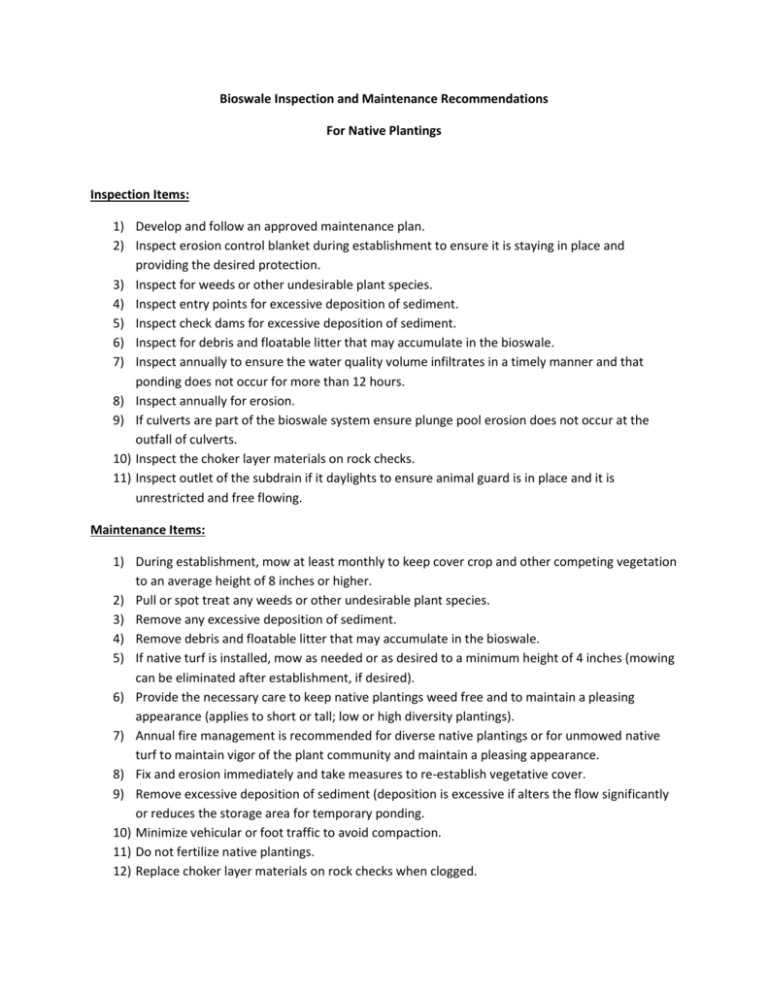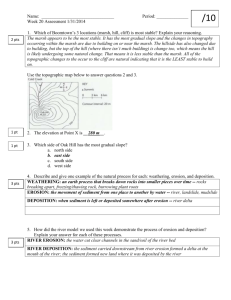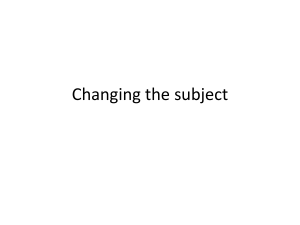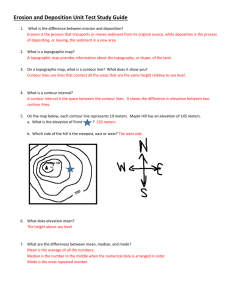Bioswale Maintenance
advertisement

Bioswale Inspection and Maintenance Recommendations For Native Plantings Inspection Items: 1) Develop and follow an approved maintenance plan. 2) Inspect erosion control blanket during establishment to ensure it is staying in place and providing the desired protection. 3) Inspect for weeds or other undesirable plant species. 4) Inspect entry points for excessive deposition of sediment. 5) Inspect check dams for excessive deposition of sediment. 6) Inspect for debris and floatable litter that may accumulate in the bioswale. 7) Inspect annually to ensure the water quality volume infiltrates in a timely manner and that ponding does not occur for more than 12 hours. 8) Inspect annually for erosion. 9) If culverts are part of the bioswale system ensure plunge pool erosion does not occur at the outfall of culverts. 10) Inspect the choker layer materials on rock checks. 11) Inspect outlet of the subdrain if it daylights to ensure animal guard is in place and it is unrestricted and free flowing. Maintenance Items: 1) During establishment, mow at least monthly to keep cover crop and other competing vegetation to an average height of 8 inches or higher. 2) Pull or spot treat any weeds or other undesirable plant species. 3) Remove any excessive deposition of sediment. 4) Remove debris and floatable litter that may accumulate in the bioswale. 5) If native turf is installed, mow as needed or as desired to a minimum height of 4 inches (mowing can be eliminated after establishment, if desired). 6) Provide the necessary care to keep native plantings weed free and to maintain a pleasing appearance (applies to short or tall; low or high diversity plantings). 7) Annual fire management is recommended for diverse native plantings or for unmowed native turf to maintain vigor of the plant community and maintain a pleasing appearance. 8) Fix and erosion immediately and take measures to re-establish vegetative cover. 9) Remove excessive deposition of sediment (deposition is excessive if alters the flow significantly or reduces the storage area for temporary ponding. 10) Minimize vehicular or foot traffic to avoid compaction. 11) Do not fertilize native plantings. 12) Replace choker layer materials on rock checks when clogged. 13) Replace animal guard if/as needed and remove any retrictions at a daylighted outlet to ensure that is free flowing. Bioswale Inspection and Maintenance Recommendations For Non-Native Plantings Inspection Items: 1) Develop and follow an approved maintenance plan. 2) Inspect erosion control blanket during establishment to ensure it is staying in place and providing the desired protection. 3) Inspect for weeds or other undesirable plant species. 4) Inspect entry points for excessive deposition of sediment. 5) Inspect check dams for excessive deposition of sediment. 6) Inspect of debris and floatable litter that may accumulate in the bioswale. 7) Inspect annually to ensure the water quality volume infiltrates in a timely manner and that ponding does not occur for more than 12 hours. 8) Inspect annually for erosion. 9) If culverts are part of the bioswale system ensure plunge pool erosion does not occur at the outfall of culverts. 10) Inspect the choker layer materials on rock checks. 11) Inspect outlet of the subdrain if it daylights to ensure animal guard is in place and it is unrestricted and free flowing. 12) Maintenance Items: 1) During establishment, mow at least monthly to keep cover crop and other competing vegetation to an average height oches or higher. 2) Pull or spot treat any weeds or other undesirable plant species. 3) Remove any excessive deposition of sediment. 4) Remove debris and floatable litter that may accumulate in the bioswale. 5) Fix and erosion immediately and take measures to re-establish vegetative cover. 6) Remove excessive deposition of sediment (deposition is excessive if alters the flow significantly or reduces the storage area for temporary ponding. 7) Minimize vehicular or foot traffic to avoid compaction. 8) Replace choker layer materials on rock checks when clogged. 9) Minimize mowing and mow to maintain the maximum possible vegetative height. 10) Replace animal guard if/as needed and remove any retrictions at a daylighted outlet to ensure that is free flowing. 11)








